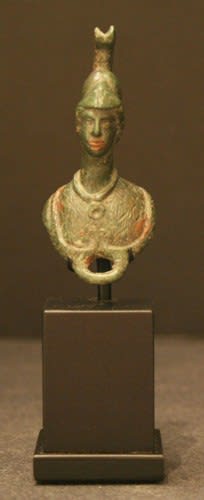Roman Bronze Applique Bust of Athena / Minerva, 1st Century CE - 3rd Century CE
Bronze
2.25
SP.200
Further images
This style of bronze appliqué is well attested in Roman imperial artwork, yet each such piece is unique in its dedication to this style. Such objects were often attached to...
This style of bronze appliqué is well attested in Roman imperial artwork, yet each such piece is unique in its dedication to this style. Such objects were often attached to larger works of art, such as furniture or other home adornments. The elements with which the appliqué would be attached are evident at the rear of the piece, as well as in the ring at the base of the item’s front. Around her neck she wears a simple pendant, and her countenance is stoic and proud.
In this depiction, Athena, or Minerva as the Romans called her, conforms to traditional iconography in which she wears a classical Greek helmet of the Corinthian variety, bearing a tall crest, perhaps imagined by the artist as made of feathers or horsehair. Interestingly, her lips bear a red color from the patina that has come to rest upon the bronze, as if it were applied through cosmetics in an attempt to accentuate her attractiveness and rival the beauty of Aphrodite.
While Athena may not have been known particularly for her beauty, her attributes were many and Athena was the goddess of combat and wisdom and was the daughter of Zeus himself. Juxtaposing the frenzied and maniacal warlike nature of Ares, the god of war, she represented a more noble and personal type of combat that valued bravery and skill over sheer bloodshed and carnage. Thus, her gentility connected her to wisdom as well. Originally the patron deity of Athens, a renowned statue of her (the Palladium) was also reportedly present in the city of Troy, and after the sack of that city it was dutifully carried by the warrior Aeneas to Italy where his descendents would one day found the city of Rome. Thus the Romans imagined themselves to have an intimate connection with the goddess just as did the Athenians. As the Romans conceived of her, Minerva even held a place beside her father, Jupiter, and her mother, Juno, as a member of the Capitoline Triad, perhaps the most important grouping of deities in Rome. Her statue stood, along with that of her mother, both on opposing sides flanking that of her father, in the Temple of Jupiter Capitolinus, illustrating her extraordinary importance to the Romans.
The mundane employment of this item in daily usage is far from disrespectful to the goddess; rather it invites her into the realm of daily contact with human life, giving her a place of honor and showing her the love and respect owed to a protectress and patroness of both the Athenian and Roman people.
In this depiction, Athena, or Minerva as the Romans called her, conforms to traditional iconography in which she wears a classical Greek helmet of the Corinthian variety, bearing a tall crest, perhaps imagined by the artist as made of feathers or horsehair. Interestingly, her lips bear a red color from the patina that has come to rest upon the bronze, as if it were applied through cosmetics in an attempt to accentuate her attractiveness and rival the beauty of Aphrodite.
While Athena may not have been known particularly for her beauty, her attributes were many and Athena was the goddess of combat and wisdom and was the daughter of Zeus himself. Juxtaposing the frenzied and maniacal warlike nature of Ares, the god of war, she represented a more noble and personal type of combat that valued bravery and skill over sheer bloodshed and carnage. Thus, her gentility connected her to wisdom as well. Originally the patron deity of Athens, a renowned statue of her (the Palladium) was also reportedly present in the city of Troy, and after the sack of that city it was dutifully carried by the warrior Aeneas to Italy where his descendents would one day found the city of Rome. Thus the Romans imagined themselves to have an intimate connection with the goddess just as did the Athenians. As the Romans conceived of her, Minerva even held a place beside her father, Jupiter, and her mother, Juno, as a member of the Capitoline Triad, perhaps the most important grouping of deities in Rome. Her statue stood, along with that of her mother, both on opposing sides flanking that of her father, in the Temple of Jupiter Capitolinus, illustrating her extraordinary importance to the Romans.
The mundane employment of this item in daily usage is far from disrespectful to the goddess; rather it invites her into the realm of daily contact with human life, giving her a place of honor and showing her the love and respect owed to a protectress and patroness of both the Athenian and Roman people.







